
Samson of Dol was a Welsh saint, who is also counted among the seven founder saints of Brittany with Pol Aurelian, Tugdual or Tudwal, Brieuc, Malo, Patern (Paternus) and Corentin. Born in southern Wales, he died in Dol-de-Bretagne, a small town in north Brittany.

Ceredig ap Cunedda, was king of Ceredigion in Wales.
Einion Yrth ap Cunedda, also known as Einion Yrth, was a king of Gwynedd. He is claimed as an ancestor of the later rulers of North Wales.

Brioc was a 5th-century Welsh holy man who became the first abbot of Saint-Brieuc in Brittany. He is one of the seven founder saints of Brittany.

Saint Cadoc or Cadog was a 5th–6th-century Abbot of Llancarfan, near Cowbridge in Glamorgan, Wales, a monastery famous from the era of the British church as a centre of learning, where Illtud spent the first period of his religious life under Cadoc's tutelage. Cadoc is credited with the establishment of many churches in Cornwall, Brittany, Dyfed and Scotland. He is known as Cattwg Ddoeth, "the Wise", and a large collection of his maxims and moral sayings were included in Volume III of the Myvyrian Archaiology. He is listed in the 2004 edition of the Roman Martyrology under 21 September. His Norman-era "Life" is a hagiography of importance to the case for the historicity of Arthur as one of seven saints' lives that mention Arthur independently of Geoffrey of Monmouth's Historia Regum Britanniae.
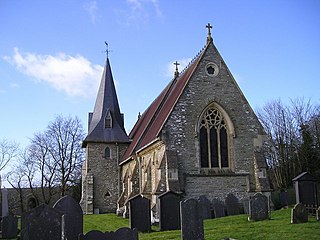
Saint Cynllo is a British saint, who lived in the late 5th and early 6th centuries, generally described as a brother of Saint Teilo. Cynllo was known for "...the sanctity of his life and the austerity of his manners."
Kea was a late 5th-century British saint from the Hen Ogledd —the Brythonic-speaking parts of what is now southern Scotland and northern England. According to tradition he was chiefly active in Cornwall, Devon and Brittany, and his cult was popular in those regions as well as throughout Wales and the West Country. Fili or Filius, to whom the parish church of Philleigh is dedicated, probably came from Wales and is said to have been a companion of Kea.
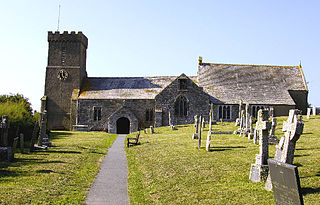
Crantock is a coastal civil parish and village in Cornwall, England, two miles (3 km) southwest of Newquay.

Cubert is a village in Cornwall, England, United Kingdom. It is three miles (5 km) south-southwest of Newquay and is in the civil parish of Cubert.
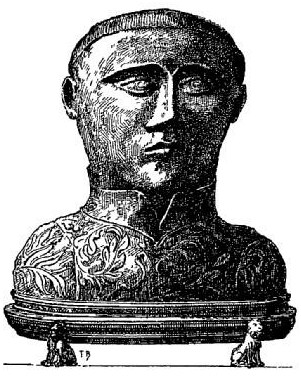
Winwaloe was the founder and first abbot of Landévennec Abbey, also known as the Monastery of Winwaloe. It was just south of Brest in Brittany, now part of France.
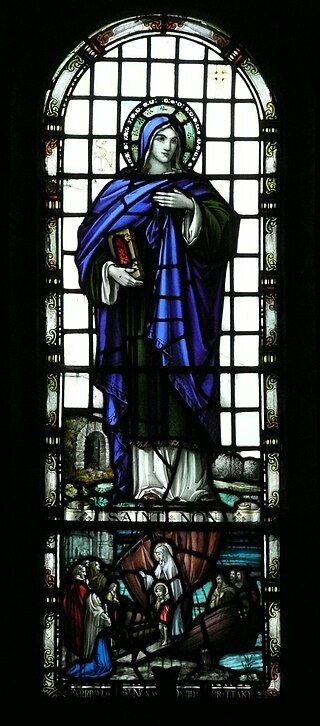
Non was, according to Christian tradition, the mother of Saint David, the patron saint of Wales.
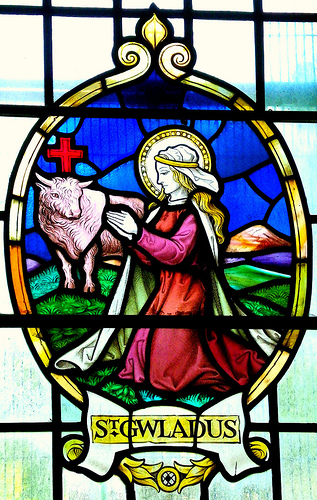
Saint Gwladys ferch Brychan or St Gladys, daughter of King Brychan of Brycheiniog, was the queen of the saint-king Gwynllyw Milwr and the mother of Cadoc "the Wise", whose Vita may be the earliest saint's life to mention Arthur. Gwladys's other children were Cynidr, Bugi, Cyfyw, Maches, Glywys II and Egwine. Today her main church and associated school is in Bargoed.

Padarn was an early 6th century British Christian abbot-bishop who founded Saint Padarn's Church in Ceredigion, Wales. He appears to be the same individual as the first bishop of Braga and Saint Paternus of Avranches in Normandy. Padarn built a monastery in Vannes and is considered one of the seven founding saints of Brittany. His early vita is one of five insular and two Breton saints' lives that mention King Arthur independently of Geoffrey of Monmouth's Historia Regum Britanniae.

St Carantoc's Church, Crantock is in the village of Crantock, Cornwall, England. Since 1951 the church has been designated as a Grade I listed building. It is an active Anglican parish church in the diocese of Truro, the archdeaconry of Cornwall and the deanery of Pydar. Its benefice is combined with that of St Cubert.
Cadfan, was the 6th century founder-abbot of Tywyn and Bardsey, both in Gwynedd, Wales. He was said to have received the island of Bardsey from Einion Frenin, king of Llŷn, around 516 and to have served as its abbot until 542.

Saint Teilo, also known by his Cornish name Eliud, was a British Christian monk, bishop, and founder of monasteries and churches. He was from Penalun (Penally) near Tenby in Pembrokeshire, south Wales.
Saint Sulien, Sulian, or Silin was the reputed 6th-century founder-abbot of a monastery at Luxulyan in Cornwall. His feast day is 29 July. He is likely the same as the Saint Sulien of Cornouaille and Domnonée. The prefix "lux" is equivalent to "loc" which means place. It is common in Brittany, but not in Cornwall, which suggests this is a Breton foundation.
Saint Tathan is claimed to be a fifth or sixth century Celtic saint, who travelled from Ireland to Wales where he founded a Christian church. He is reckoned an early abbot of Caerwent and has dedications at Llanvaches, near Caerwent, also known as Llandathan, and at St Athan. He is said to have been a teacher of Cadoc and to have brought light to the heathens to undo the work of Satan.

A Saint Ilar is listed among the 6th-century saints of Wales and is the probable namesake of Llanilar in Ceredigion and its former hundred of Ilar. His feast day is variously given as 13, 14, or 15 January, but is no longer observed by either the Anglican or Catholic church in Wales.













